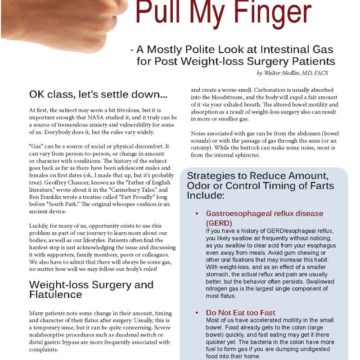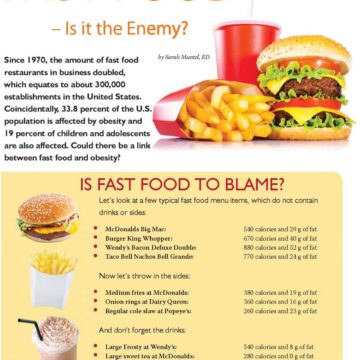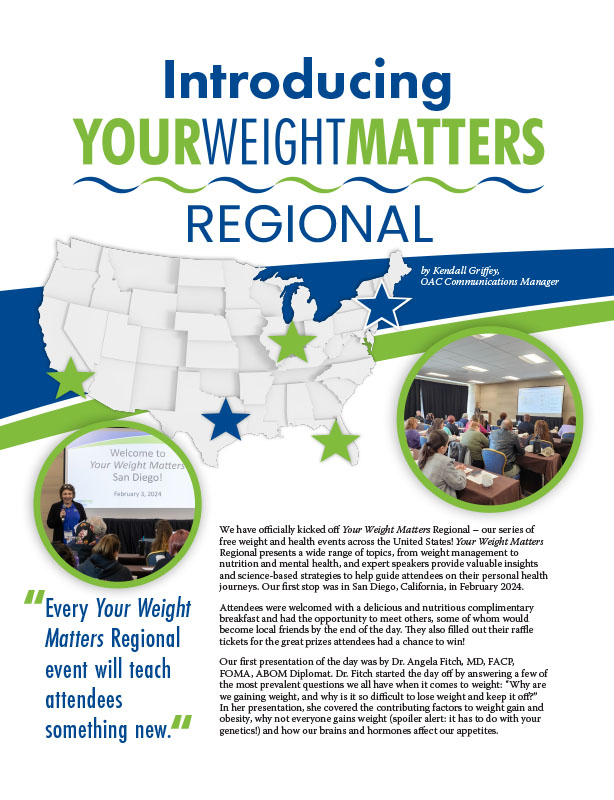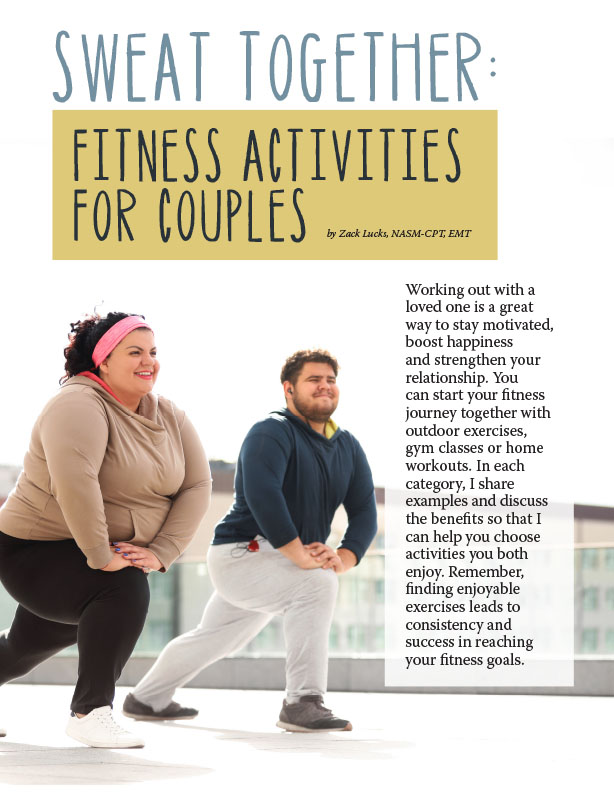Putting the Science behind Exercise – Workout Smarter, Not Harder

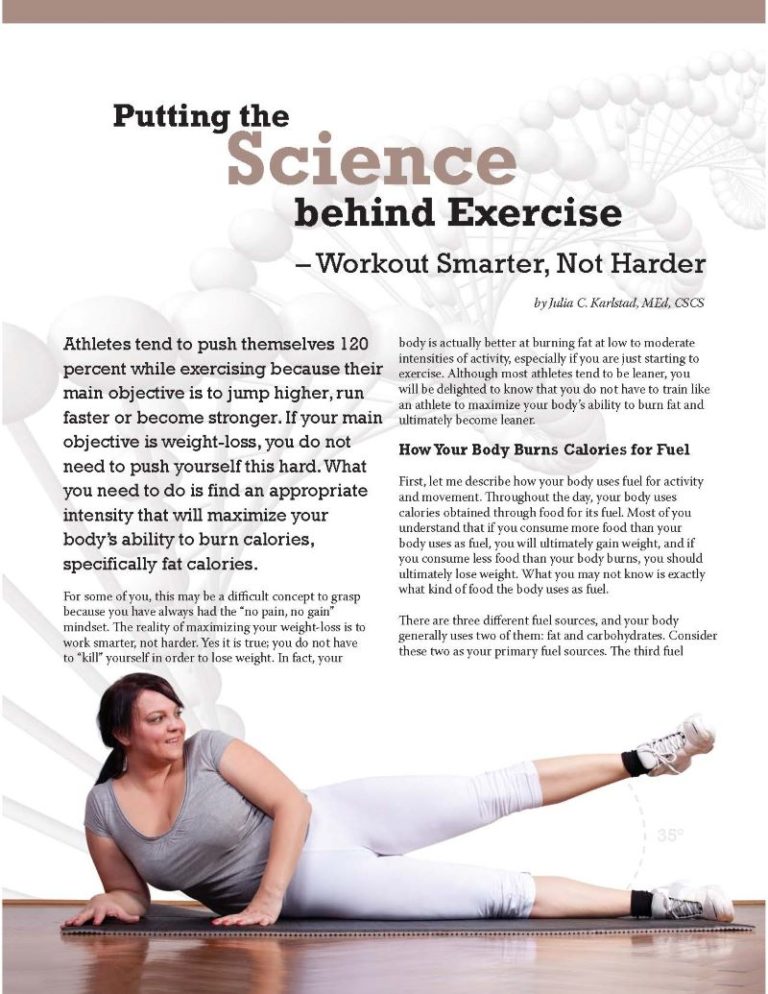
by Julia C. Karlstad, MEd, CSCS
Spring 2012
Athletes tend to push themselves 120 percent while exercising because their main objective is to jump higher, run faster or become stronger. If your main objective is weight-loss, you do not need to push yourself this hard. What you need to do is find an appropriate intensity that will maximize your body’s ability to burn calories, specifically fat calories.
For some of you, this may be a difficult concept to grasp because you have always had the “no pain, no gain” mindset. The reality of maximizing your weight-loss is to work smarter, not harder. Yes it is true; you do not have to “kill” yourself in order to lose weight. In fact, your body is actually better at burning fat at low to moderate intensities of activity, especially if you are just starting to exercise. Although most athletes tend to be leaner, you will be delighted to know that you do not have to train like an athlete to maximize your body’s ability to burn fat and ultimately become leaner.
How Your Body Burns Calories for Fuel
First, let me describe how your body uses fuel for activity and movement. Throughout the day, your body uses calories obtained through food for its fuel. Most of you understand that if you consume more food than your body uses as fuel, you will ultimately gain weight, and if you consume less food than your body burns, you should ultimately lose weight. What you may not know is exactly what kind of food the body uses as fuel.
There are three different fuel sources, and your body generally uses two of them: fat and carbohydrates. Consider these two as your primary fuel sources. The third fuel source is protein. Protein is not an efficient fuel source. Protein’s main purpose is to build and repair tissue, not to provide fuel or energy. Although, eating protein is important for people trying to lose weight because they need to preserve their lean muscle through the weight-loss phase.
The idea is to prevent the body from tapping into lean muscle mass for fuel during the caloric restriction phase of any diet. This is essential because lean muscle helps stoke the metabolism because it takes more energy to sustain lean muscle versus fat mass.
Fat and Carbohydrates: Your Body’s Two Main Fuel Sources
Okay, enough about protein. What about fat and carbohydrates? I mentioned that these are the fuels we need to burn in order to go about our daily lives. Let’s start with fat, since it is really what most people are concerned with. Fat is utilized both at rest and during activity. How you metabolize or burn fat at rest is most directly related to what you eat; your body will burn what you feed it.
The analogy of your body being like a car should help explain this concept. If you put premium unleaded fuel in your car, that is what it is going to burn. By the same token, if you put regular unleaded fuel in your car, it has no choice but to burn the regular unleaded fuel. Your body works in a similar fashion. If you eat a diet rich in fat, it will burn a majority of its calories at rest from fat. Similarly, if you eat breads, pastas, fruits and vegetables, your body will burn a majority of carbohydrates at rest.
Genetics and a Healthy Diet Play a Part
Now, it does not always work out exactly this way because our bodies consist of tiny components called genes. I am sure you realize that part of the reason you may be the way you are is because of your genetic makeup, or heredity. In other words, some of us were simply born fat burners.
Yes, we have all met these people. You know, the ones that can sit around the office and munch on donuts in the morning, eat out for lunch every day, enjoy a candy bar in the afternoon, and never gain a pound. You probably “hate” these people. And then, others are just good carbohydrate (carb) burners. Their bodies “want” to burn carbohydrates and they hardly burn an ounce of fat at rest. You can “thank” your parents, grandparents, aunts and uncles for these traits; however, if you are not a born fat burner, do not dismay because you can do a lot to combat some of those non-fat burning traits you inherited.
One of the fastest ways to burn more fat at rest is to eat a well-balanced diet. If you eat a diet consisting of the right amount of carbohydrates, fats and protein, your body will burn about 60 percent of your calories from fat and about 40 percent from carbohydrates in a resting state. That is not a bad ratio of fat burn, simply from eating sensibly.
Diets that are high in protein and low in carbohydrate will significantly help create an even better fat-burning body. These diets essentially force your body to burn fat because you are not consuming the easily digested carbohydrate and the body does not like to use protein for fuel. Thus, the body turns to the stored fat and begins to break it down for fuel. This process is called ketosis. The body breaks down fat to produce glucose and a byproduct, called ketones, to use for fuel.
The Body Burns Fuel Differently at Different Times
You may be wondering what “at rest means.” It refers to a resting state, as opposed to a physically active state. When you are exercising, your body burns fuel a bit differently. What type of calories you burn at rest has everything to do with your diet and genetics, whereas what type you burn while exercising has everything to do with your fitness level. Generally speaking, your body will burn fat or carbohydrate for fuel during exercise just as it does in a resting state, but your body will burn fat better at low to moderate workout intensities. The more intense your exercise, the more carbohydrates your body will burn. The reason for this is because it takes a lot longer to break down and metabolize or burn fat.
The bottom line is, you will burn a greater percentage of fat exercising at lower intensities. This is especially the case for those of you that are just starting an exercise regimen. Great news for anyone trying to lose weight – you do not have to “kill” yourself in order to lose fat pounds.
Keep in mind that the body must utilize oxygen in order to burn fat. Aerobic exercise basically means exercise involving the intake of oxygen. When you exercise aerobically, you are utilizing a large amount of oxygen to burn calories. Conversely, anaerobic exercise means exercising at a level at which oxygen debt occurs because the need for oxygen exceeds the capacity of the circulation to supply it. This generally occurs with short bursts of high-intensity exercise such as a 100-meter dash, vertical jumps, power lifts, or the explosiveness of a defensive lineman at the snap of a football.
When the body is in an anaerobic state, it is only capable of burning carbohydrates. The best thing about this whole process is that you can actually make your body more efficient at burning fat at higher intensities and longer durations through training, specifically heart rate training. This should ultimately be everyone’s goal. If you are disciplined in training specifically to create the best fat-burning body possible, you will inevitably have an easier time losing weight and ultimately be able to maintain a healthy weight once you achieved your target weight. This helps explain why fit people tend to be leaner. They have created a body that is very good at burning fat; therefore, it is easier for them to manage their weight.
Let me explain how your body uses carbohydrates for fuel. Carbs are the preferred fuel source to some degree. The reason for this is because carbs are usually abundant in our bodies and most people ingest a large number of carbs daily. In fact, the body even stores carbs in the liver and muscles. These stored carbs are called glycogen. As you begin to move, your muscles can easily use this glycogen for energy. This also explains why your body will resort to burning more carbs when you exercise at higher intensities. More intense exercise requires quick energy, so the body resorts to burning carbs because it can get to them faster and break them down more quickly than the other two macronutrients (fat and protein).
This is great news, right? You are probably thinking, “Yeah, yeah… but how do I do it? How do I exercise to create the most efficient fat-burning system? Do I just start moving, and if so, for how long, how frequently, and how strenuously? Should I walk, bike, swim or lift weights?” These are all great questions.
Benefits of Heart Rate Monitoring and Metabolic Testing
Aside from proper diet, cardiovascular exercise is the main support on which to lean for weight-loss, specifically fat-loss. The key is to know the point (exercise intensity) at which your body is most effective at burning fat. This is where heart-rate monitoring comes into play. Most of us have heard of people using a heart rate monitor while exercising. The reason you would want to do this is to ensure that you are training at the optimal intensity level to burn fat most efficiently.
The point at which you are most effective at burning fat is considered to be your target heart rate, or aerobic base. It is the level of intensity, measured in beats per-minute, at which your body can burn the most number of fat calories per-minute. This is important to know if your main objective is fat-loss.
Now, everyone is different as to the point or exercise intensity that they are most efficient at burning fat. Generally speaking, you will burn fat better at those low to moderate intensities, but if you really want to be specific and put the science behind your workouts, you should get assessed through metabolic testing. This is the most effective method of measuring one’s aerobic base or maximum fat burning capacity. Check your local health clubs to see if any of them offer this testing, also known as indirect calorimetry, maximum oxygen update, or O2 testing.
Summing it All up
You might say, “Yes, but this goes against everything I have ever known or been told. I always thought you had to be huffing and puffing, or you were not really doing any good.” It is important to point out that there is a fine line here. The harder you work, the more total calories your body will burn; however, several problems come into play.
Most of you will not able to sustain this level of intensity, and it is fairly hard on your joints if you have not exercised consistently for some time. The other important consideration (and possible problem) is that you will be burning a greater percentage of carbs. You might be thinking, “Well, a calorie is a calorie, is a calorie, right?” Well, not exactly.
Keep in mind that if you are combining your new exercise with a sensible diet that is generally low in carbs and high in lean protein (a very popular and effective diet for those trying to reduce their weight), you are really not consuming many carbs. So if you are not eating many carbs and you have a whole lot of body fat to tap into, why would you want to burn more carbs through exercise? This would make it that much more difficult to stay on your diet after your workout.
If you burn a bunch of carbs during exercise, your body will tend to crave carbs post-workout, especially because you have been restricting them – not to mention that the fat you were trying to burn off during exercise is still hanging on, literally. This is not what you want to accomplish. You can get yourself into a vicious and frustrating cycle by trying to exercise like this. The idea is to force your body to burn fat both through exercise and diet. If you are working hard in the gym, be sure you are burning and wasting away fat, not time.
About the Author:
Julia Karlstad, MEd, CSCS, is the president of JKFITNESS, LLC. Julia has worked in the fitness industry and specifically the medical wellness community for several years. Previously, Julia developed and directed an exercise physiology program for two bariatric hospitals and three medically supervised weight-loss clinics. She currently serves on the OAC Advisory Board and authors a bi-monthly column in the “Walk from Obesity” e-newsletter. For more information on Julia, please visit www.juliakarlstad.com or www.jk-fit.com.
by Yelena Kibasova Spring 2024 The fitness world is evolving, with new trends and innovations that promise…
Read Articleby Kendall Griffey, OAC Communications Manager Spring 2024 We have officially kicked off Your Weight Matters Regional…
Read Articleby Zack Lucks, NASM-CPT, EMT Winter 2024 Working out with a loved one is a great way…
Read Article




